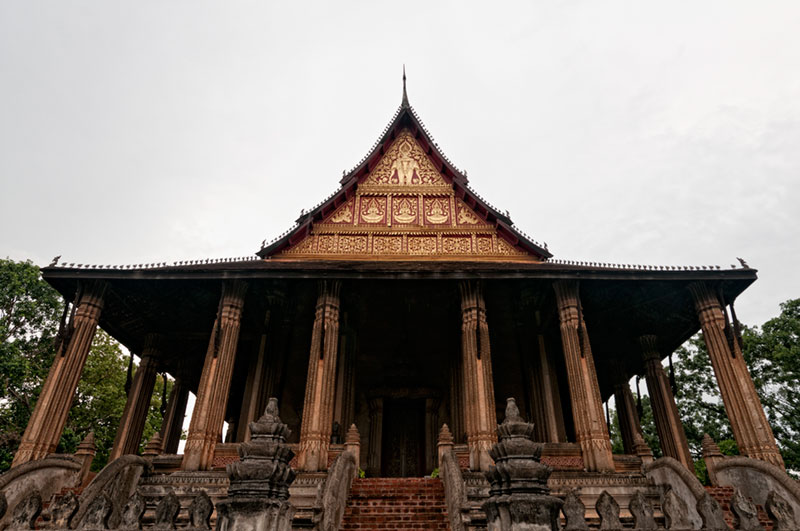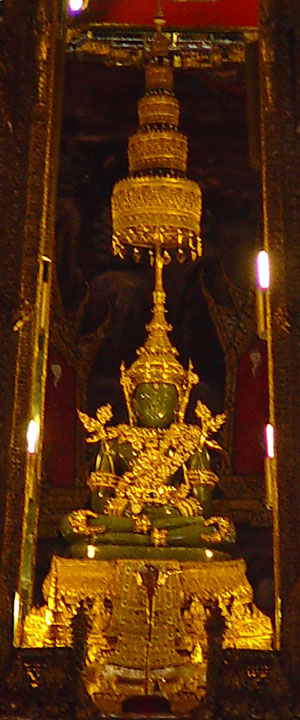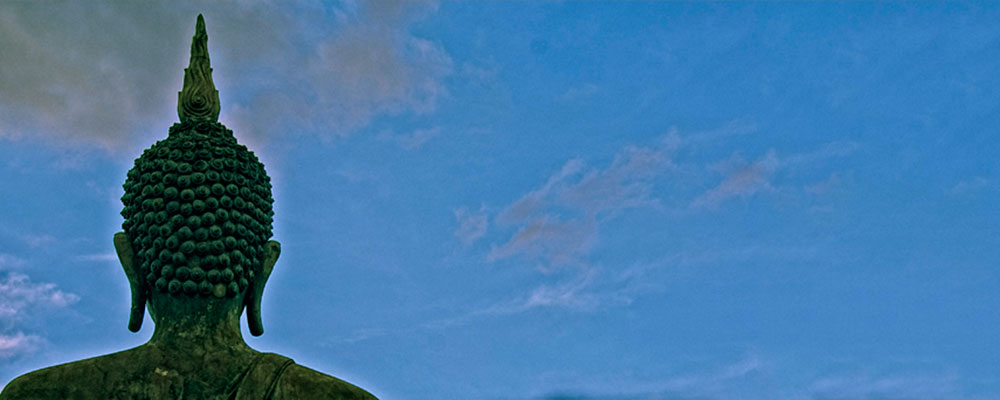An exploration of the history and lore of the Emerald Buddha, a green statue that resides in Bangkok, Thailand’s Wat Phra Kaeo and watches over Thailand.
Emerald Buddha • Symbol of the Kingdom of Thailand
Among the greatest symbols of Thailand is the small green statue that rests inside Bangkok's Wat Phra Kaeo. Known as the Emerald Buddha (พระแก้วมรกต – Phra Kaeo Morakot, or พระพุทธมหามณีรัตนปฏิมากร – Phra Phuttha Maha Mani Rattana Patimakon), much about this carving remains mysterious to this day. The following account tells the tale of this extraordinary icon that watches over the Thai nation.
Nearly six hundred years ago, lightning struck a stupa in the northern Thai city of Chiang Rai, exposing a gold-leaf covered Buddha statue. Believing the image to be made of ordinary stone, the temple's monks placed it next to other statues in the temple's sanctuary.
Several months later, the plaster coating the statue chipped off at the nose, revealing a green color beneath. The monks then peeled away the plaster, uncovering a magnificent statue without blemish carved from a single piece of stone. It was immediately christened Phra Kaeo Morakot – Emerald Buddha, and people from around the region flocked to see it.
Shortly after its discovery, the Lannathai ruler of Chiang Mai ordered an elephant procession to bring the Emerald Buddha to that city. But the impertinent pachyderm carrying the statue had a mind of its own and, at a fork in the road, plodded towards Lampang. Repeatedly the mahout attempted to turn the beast towards Chiang Mai, but to no avail. Believing this to be a heavenly sign, the Emerald Buddha was instead interred at a temple at Lampang. It was not until 1468 when it was finally brought to Chiang Mai. There it remained until 1552, when it was brought to Luang Prabang, in what is now Laos. When the Lao king moved his capital to Vientiane in 1564, the Emerald Buddha went with him, staying for over 200 years.
By the eighteenth century, Siam was being ruled King Taksin the Great, who had succeeding in expelling the Burmese invaders who had destroyed the former capital at Ayutthaya. Following this success, he began consolidating the various far-flung portions of the realm. In 1779, Taksin's top general, Chao Phraya Chakri, captured Vientiane and returned the Emerald Buddha to Siam, where it was installed in the new Thai capital at Thonburi. After he became King Rama I of Thailand, both the capital and Emerald Buddha were moved across the river, to present-day Bangkok. With great ceremony, the Emerald Buddha was installed at Wat Phra Kaew on March 22, 1784, where it remains to this day.
 Vientiane's Haw Pha Kaew, which housed the Emerald Buddha from 1564 to 1779. Photo: Richard W. Hughes
Vientiane's Haw Pha Kaew, which housed the Emerald Buddha from 1564 to 1779. Photo: Richard W. Hughes
The Chronicle of the Emerald Buddha
A mythical account of the statue known as the Emerald Buddha has been translated from Pali from palm-leaf manuscripts. The Wikipedia summarizes it as follows:
According to legend, the Emerald Buddha was created in India in 43 BC by Nagasena in the city of Pataliputra (today Patna). The legends state that after remaining in Pataliputra for three hundred years, it was taken to Sri Lanka to save it from a civil war. In 457, King Anuruth of Burma sent a mission to Ceylon to ask for Buddhist scriptures and the Emerald Buddha, in order to support Buddhism in his country. These requests were granted, but the ship lost its way in a storm during the return voyage and landed in Cambodia. When the Thais captured Angkor Wat in 1432 (following the ravage of the bubonic plague), the Emerald Buddha was taken to Ayutthaya, Kamphaeng Phet, Laos and finally Chiang Rai, where the ruler of the city hid it. Cambodian historians recorded capture of the Buddha statue in their famous Preah Ko Preah Keo legend. However, some art historians describe the Emerald Buddha as belonging to the Chiang Saen Style of the 15th Century AD, which would mean it is actually of Lannathai origin.
In size, the Emerald Buddha is approx. 66 cm tall by 42 cm wide, and is adorned with garments made of gold. There are three sets of gold clothing, corresponding to Thailand's three seasons—hot (March–June), rainy (July–October) and cool (November–February). The changing of garments is performed personally by the King in a ceremony of great pomp and grandeur.
While there are various suggestions that the the statue is made of jasper or even jadeite, the reality is that the Emerald Buddha has never been tested and thus its exact composition is as great a mystery as its origin.
Thailand's Wat Phra Kaeo (Temple of the Emerald Buddha) is the most sacred in the Kingdom. It is said that the older a Buddha image is, the more power it has. With its long and storied history, Thailand's Emerald Buddha is a powerful force indeed—a symbol of both kingdom and people.
 A close up of the Emerald Buddha in summer attire. Photo: Wikipedia
A close up of the Emerald Buddha in summer attire. Photo: Wikipedia

References & further reading
- Anonymous (1932) The Chronicle of the Emerald Buddha. Translated from Thai by Camille Notton, Bangkok, Bangkok Times Press.
- Narula, K.S. (1994) Voyage of the Emerald Buddha. Kuala Lumpur, Oxford Univ. Press, 88 pp.
- Roeder, Eric (1999) The origin and significance of the Emerald Buddha. Explorations in Southeast Asian Studies, Vol. 3, Fall.
- Suphamard, Thongsib (n.d.) Phra Kaeo Morakot. [in Thai], Silapakorn University, Bangkok.
About the author
Richard W. Hughes is one of the world’s foremost experts on ruby and sapphire. The author of several books and over 170 articles, his writings and photographs have appeared in a diverse range of publications, and he has received numerous industry awards. Co-winner of the 2004 Edward J. Gübelin Most Valuable Article Award from Gems & Gemology magazine, the following year he was awarded a Richard T. Liddicoat Journalism Award from the American Gem Society. In 2010, he received the Antonio C. Bonanno Award for Excellence in Gemology from the Accredited Gemologists Association. The Association Française de Gemmologie (AFG) in 2013 named Richard as one of the fifty most important figures that have shaped the history of gems since antiquity. In 2016, Richard was awarded a visiting professorship at Shanghai's Tongji University. 2017 saw the publication of Richard's Ruby & Sapphire: A Gemologist's Guide, arguably the most complete book ever published on a single gem species and the culmination of nearly four decades of work in gemology.

